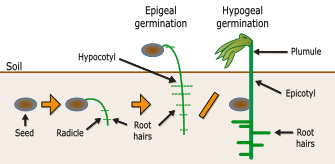Epigeal germination
Epigeal germination (Ancient Greek ἐπίγαιος [epígaios] 'above ground', from ἐπί [epíon' and γῆ [gê] 'earth, ground') is a botanical term indicating that the germination of a plant takes place above the ground. An example of a plant with epigeal germination is the common bean (Phaseolus vulgaris). The opposite of epigeal is hypogeal (underground germination). Epigeal is also not the same as hypogeal germination; both epigeal and hypogeal plants will grow differently.

Epigeal germination
Epigeal germination implies that the cotyledons are pushed above ground. The hypocotyl elongates while the epicotyl remains the same in length. In this way, the hypocotyl pushes the cotyledon upward.
Normally, the cotyledon itself contains very little nutrients in plants that show this kind of germination. Instead, the first leaflets are already folded up inside it, and photosynthesis starts to take place in it rather quickly.[1]
Because the cotyledon is positioned above the ground it is much more vulnerable to damage like night-frost [2] or grazing. The evolutionary strategy is that the plant produces a large number of seeds, of which statistically a number survive.
Plants that show epigeal germination need external nutrients rather quickly in order to develop, so they are more frequent on nutrient-rich soils. The plants also need relatively much sunlight for photosynthesis to take place. Therefore they can be found more often in the field, at the border of forests, or as pioneer species.[1]
Plants that show epigeal germination grow relatively fast, especially in the first phase when the leaflets unfold. Because of this, they occur frequently in areas that experience regular flooding, for example at the river borders in the Amazon region. The fast germination enables the plant to develop before the next flooding takes place.[1] After the faster first phase, the plant develops more slowly than plants that show hypogeal germination.
It is possible that within the same genus one species shows epigeal germination while another species shows hypogeal germination. Some genera in which this happens are:
- Phaseolus: the common bean (Phaseolus vulgars) shows epigeal germination, whereas the runner bean (Phaseolus coccineus) shows hypogeal germination
- Lilium: see Lily seed germination types
- Araucaria: species in the section Eutacta show epigeal germination, whereas species in the section Araucaria show hypogeal germination
Phanerocotylar vs. cryptocotylar
In 1965, botanist James A. Duke introduced the terms phanerocotylar and cryptocotylar as synonyms for epigeal and hypogeal respectively, because he didn't consider these terms etymologically correct.[3] Later, it was discovered that there are rare cases of species where the germination is epigeal and cryptocotylar.[4] Therefore, divisions have been proposed that take both factors into account.[5]
References
- Parolin, P., Ferreira, L.V., Junk, W.J. (2003) "Germination characteristics and establishment of trees from central Amazonian flood plains" Tropical Ecology 44(2): 157-169
- Rigetti, S. (1998) Weed control in direct-seeded pea and lentil Archived 2013-10-11 at the Wayback Machine University of Saskatchewan
- Duke, J.A. (1965) "Keys for the identification of seedlings of some prominent woody species in 8 forest types in Puerto Rico" Ann. Missouri. Bot. Gard no. 52 pp. 314-350
- Franceschini, M. (2004) "An unusual case of epigeal cryptocotylar germination in Rollinia salicifolia (Annonaceae)" Botanical Journal of the Linnean Society vol. 146 no. 1
- Garwood, N.C. (1996) "Functional morphology of tropical tree seedlings", in: The ecology of tropical forest tree seedlings, pp. 59-129. New York: Swaine